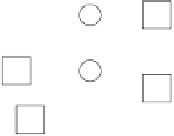Information Technology Reference
In-Depth Information
Table 1.
Mapping for data objects association with loop activities
!
DataObject
state2
DataObject
state1
Pr e v - A
A
- A- PostA
A
Po s t A
Pr e v A
A
Po s t A
DataObject_state1
DataObject_state2
A
DataObject
DataObject
state2
DataObject_state1
A- A- PostA
A
Po s t A
Pr e v A
A
Po s t A
!
Pr e v - A
DataObject_state2
A
A
DataObject
state2
DataObject_stateN
A
Pr e v A
A
Po s t A
is denoted by
M
, an m-vector, where
m
is the total number of places. The
pth
component of
M
, denoted by
M(p)
, is the number of tokens in place
p
. The firing
of an enabled transition will change the token distribution (marking) in a net [8].
We use the set of rules introduced by Awad et al. [2] to do the semantic
mapping between elements of a BP model with data objects and elements of
aPetrinet.Let
E
BP
be the set of flow nodes of a BP (model), i.e. activities,
gateways and events,
D
BP
the set of states of a data object of that BP, and
WRITERS
BP
⊆
E
BP
be the set of activities of the BP that write that data
object. The result of the semantic mapping is a Petri net with the following
characteristics:
-
The places of the Petri net are of two different kinds: control places
P
C
and
data places
P
D
. Therefore
P
=
P
C
P
D
and
P
C
P
D
=
∅
.
•
P
C
corresponds to those places that represent se-
quence flow elements (arrows) of the business process. Each
pc
i
=(
ei
i
,eo
i
),
where
ei
i
,eo
i
∈
=
{
pc
1
,pc
2
, ..., pc
n
}
E
BP
is a pair of values composed of the two flow nodes of
the business process that the sequence flow element connects.
=
D
BP
corresponds to those places that repre-
sent states of the data object whose object life cycle we are generating.
There is exactly one data place for each possible state of the data object.
-
The transitions of the Petri net represent flow nodes of the business process
model. It follows an
n
: 1 relationship, i.e., each transition represents only
one flow node of the business process and a flow node may appear several
times in a Petri net. Function
elem
:
T
PN
→
•
P
D
=
{
pd
1
,pd
2
, ..., pd
n
}
E
BP
represents such relation.







































































